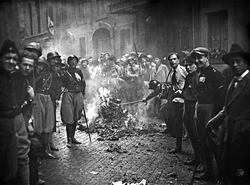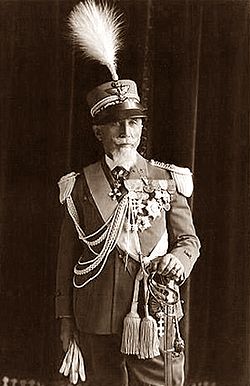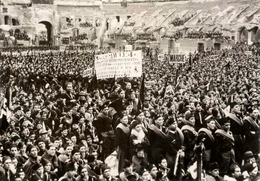Solarian War
This article is incomplete because it is pending further input from participants, or it is a work-in-progress by one author. Please comment on this article's talk page to share your input, comments and questions. Note: To contribute to this article, you may need to seek help from the author(s) of this page. |
| Solarian War | |||||||
|---|---|---|---|---|---|---|---|
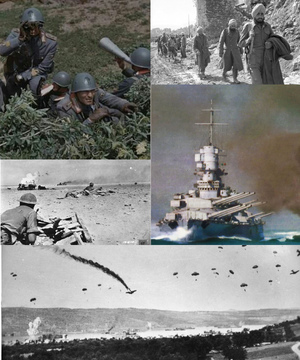 From top left clockwise: Etrurian soldiers in Paretia; Narozalic sayars during the Siege of Kassar; the ENS Imperia at the Battle of Cape Atene; Etrurian invasion of Montecara; Estmerish soldiers in northern Tsabara | |||||||
| |||||||
| Belligerents | |||||||
|
|
| ||||||
| Strength | |||||||
|
|
Details
| ||||||
| Casualties and losses | |||||||
|
998,525 dead 1,493,080 injured 285,483 missing or captured |
Total dead and missing: XXXX dead and XXX missing Details
| ||||||
|
Total civilians killed: 2-3 million Piraea: Amathia: Etruria: Auratia: Satria: Zorasan Tsabara: | |||||||
The Solarian War, known in Etruria as the Second War (Etrurian: Seconda Guerra) took place between the Etrurian Revolutionary Republic and a coalition of states under the Community of Nations from 7 July 1943 to 17 October 1946. Beginning as a local conflict between Etruria and Piraea it rapidily escalated and expanded, as Etruria invaded a number of colonial possessions and mandates across the Solarian Sea basin, while also confronting nationalistic uprisings in its own colonial territories.
The conflict was the world’s first major war following the Great War, which ended seven years prior in 1936. Many of the causes for the Solarian War stem from the political and diplomatic failure of the Etrurian government of the time to secure the promised territorial concessions, as well as a long entrenched far-right ultranationalist element in the Etrurian state dating from before the Great War. Incompetent economic management and poor policies regarding demobilisation provided fertile ground for far-right elements, that sought to secure “Etruria’s destiny, denied by erstwhile allies.” This political instability resulted in the Legionary Reaction on 1 April 1936, when far-right elements in the military seized power in a violent coup and established the Etrurian Revolutionary Republic – under the ideology of National Solarianism.
The new Etrurian regime immediately sought to expand its territory with plans for the annexation of Piraea and the Etrurian Occupation Zone in Amathia. The government under the two Co-Leaders, Ettore Caviglia and Aldo Tassinnari, steadily rebuilt Etruria’s military forces, maintaining the Great War period industry. Repeated skirmishes along the Piraean border aimed at provoking a conflict ultimately succeeded in late June, when 22 Etrurian soldiers were killed in one skirmish. Etruria formally declared war on 7 June and launched a full-scale invasion of Piraea. Despite Piraean resistance, the country quickly fell to the Etrurian invasion by 1 August. Emboldened by the lack of international retaliation, Etruria launched a series of coordinated simultaneous invasions of Paretia and Tsabara, this provokes a CN vote to intervene, leading to Etrurian assaults on Estmere’s colonial possessions in Satria. However, the conflict soon overstretches Etrurian forces and coupled with uprisings within its own colonial territories, the war rapidly turns against it. Successful CN and Narozalic offensives in 1945 in Paretia and Amathia respectively places Etruria itself in danger. The collapse of Etrurian forces in Coius and the loss of much of its navy at the Battle of Emessa leads to a CN naval invasion of southern Etruria, ultimately bring about the collapse of the regime. On the 17 October 1946, a civilian provisional government in Solaria declares an unconditional surrender ending the conflict.
While relatively short in comparison to the Great War, the Solarian conflict was seen as a total war, owing to the large numbers of men and the industrialised nature of production. Despite lasting only three years, the war left over 2 million combatants and civilians dead, and saw numerous atrocities committed, mostly by Etrurian forces. The most notable was the Etrurianisation of Piraea, which was declared a genocide in 1949. The war’s uniting of Euclea’s major powers played a prominent role in the establishment of the Euclean Community and consolidated the role of the Community of Nations. The war also hastened the speed of de-colonisation, with many of Etruria’s colonies granted independence, though they would fall into conflict. Etruria would be governed as a Community of Nations Mandate until 1948, when the Etrurian Third Republic was established, the conflict would leave a considerable economic toll on the country and severe ethnic tensions that would later erupt into a low-level conflict.
Origins
Pre-Great War far-right
Even before the violent seizure of power by the Revolutionary Legion of Etruria in 1938, the country and by greater extension its armed forces had been gripped by political divisions. The far-right movement in Etruria had first emerged in the late 1910s in response to the growth of the council socialist parties, such as the Etrurian Section of the Worker’s Internationale. The Great Collapse of 1915 only fuelled the equal rise of ultranationalists and functionalists. By the 1920s, the threat of a far-left take over had been crushed by the Second Republic, it made little to no effort to confront the far-right.

The rising tensions around the functionalist regime in Gaullica during the 1920s divided the Etrurian far-right, which both applauded and sought inspiration from Etruria’s northern neighbour, but equally saw it as the truest target for Etrurian expansionism. In the immediate pre-war years, the Etrurian far-right sought to realign the country in alliance with Gaullica, ostensibly shifting expansionism toward its erstwhile allies of Werania and Estmere. Many far-right groups such as the People’s Division, claimed that an ultranationalist “Solarian Bloc” would swiftly become the world’s power. The Revolutionary Legion, a relatively small group restricted to the military class in Povelia became the most vocal opponent of Gaullica and openly supported war, in turn it began to develop an alternate ultranationalist ideology that “sought Etruria’s needs and potential, being rooted in its unmatched illustrious past.” The Revolutionary Legion, though disdainful of the Republic, restrained its criticism, producing vague rhetoric and materials on Etruria being the “First Civilisation” (prima civiltà) and the natural “power of responsible leadership for the Solarian Sea.” By Etruria's entry into the war in 1927, the Revolutionary Legion had refined its anti-Gaullican message to "there can be only one successor to Solaria in her Republican and Imperial glory. It can only be the child of that Solaria - the Solaria of today in Etruria."
As the war broke out in 1926, the Etrurian government initially refused to intervene, announcing an official policy of neutrality. In secret, this policy was pursued to grant the government time to purge the most ardent Gaullican supporters from key military and government positions. The Revolutionary Legion’s anti-Gaullican position preserved its leaders’ status and positions, which would later become pivotal in its seizure of power.
Great War
Etruria's entry into the Great War on June 3 1927, began with the Attack on Neve Yam, the primary Gaullican naval base in Tsabara and the Solarian Sea. The surprise naval attack, crippled Gaullica's Solarian Fleet and granted Etruria free movement to deploy forces to its Coian colonies. The attack was masterminded by Admiral Vladko Dorčić, who was also a prominent member of the Revolutionary Legion. The successful action went far in securing the RL’s members in the higher echelons of the Etrurian armed forces throughout the war.
Despite the success at sea, Etruria rapidly found itself stalled in a violent and costly stalemate against Gaullica in the Aventine Mountains and in neighbouring Paretia. In the north and east, Etruria was succeeding in holding back Gaullican forces, but ostensibly couldn’t advance in turn, with both sides launching repeated offensives that only took a deeper toll. By 1928, Etruria’s position in Coius and Bahia was turning sour also, with successful Entente offensives into Etrurian Zorasan and Satria. It was in the violent stalemate in Euclea and near-collapse in the colonies that according to military records at the time, “the fielded soldier exhibits a degree of animalistic fury. There is an unrelenting desire among the ranks to avenge loss and defeat, be it on enemy combatants or otherwise.” As the war turned sour, many of the officer class, who had flirted with the Revolutionary Legion, openly expressed loyalty and in turn radicalised their troops. One historian noted, “stuck in the mountains and trenches, the camaraderie of war took to whole new levels, aided by the influence and words of RL officers, the stalemate, misery and bloodshed saw the army be taken from the Republican government and handed to itself under the tutelage of ultranationalists.”

By the turn of 1930, the war began to turn back into the Allies’ favour, with successful counterattacks against the Entente in central Euclea and in the Coian colonies. Etruria’s own major victory against the Entente at the Battle of Shazandar, in Zorasan saw a rout of Gaullican forces out of Pardaran and toward Tsabara. In Satria, Etrurian and Estmerish forces began successful counterattacks, and in both these theatres, these operations were led by Revolutionary Legion loyal commanders. These commanders were elevated to hero status back home, where the RL’s supporters in the factories and fields lauded them even further.
As the war continued to progress toward an allied victory, the Revolutionary Legion’s influence over the armed forces and government increased. In 1931, Alessandro Taiapetra, a prominent RL supporting journalist was appointed head of the National Mobilisation Ministry, which operated the vast propaganda machine. With the resources of the state at his disposal, Taiapetra began to infuse RL rhetoric into propaganda, with the late-war slogan of, “Where our men march, Etruria shall claim” falling into line with this development. The seizure of state propaganda by the RL served to radicalise the Etrurian general public, who by the war’s end came to share in the delusions that a victory would see Etruria “unleashed” and its borders expanded dramatically.
The end of the war and subsequent de-mobilisation would see the return of thousands of radicalised soldiers to their homes, workplaces and communities, securing the Revolutionary Legion and its supporting parties a solid support base of war veterans and serving officers.
Great Betrayal
The Great War ended on 12 February 1935 with Etruria and the Grand Alliance victorious over Gaullica and the Entente. The war had cost Etruria an estimated 669,000 military lives and almost 100,000 civilian, with over a million soldiers wounded. Despite the cost, the Etrurian public were confident that the losses would be compensated with the "appropriate reward of Etruria being secure as one of the true greatest powers of history." In the consequent peace negotiations, the Etrurian government was represented by civilian diplomats elected by the civilian parliament in January. Over the course of several weeks, it became public knowledge that Etruria would not be granted its claimed territories, despite the pre-war promises from Estmere and Werania. On 2 March, it was revealed that Etruria would not be granted dominion over Ajahadya, in contravention of the secret and separate Peace of Vadavarja, nor would Sangté be transferred to Etruria. This news was met with mass protests in back home, with thousands of veterans and civilians taking to the streets to denounce the government and negotiatiors.
On 10 March, it was revealed that Tsabara would become a Mandate under Estmere, denying the request that the Gaullican colony be handed over to Etruria. This was followed the next day by confirmation that Garambura would also be granted independence, Piraea would only cede Tarpeia and Gaullica would only cede the Portata Settentrionale and not key strips of the northern side of the Aventines. The denial of expansion into Badawiya and Bahia respectively threw the country into chaos, as even restrained liberal and centrist politicians denounced the government. On 20 March, the Social Democratic Party withdrew from the national coalition government in protest, the SDP was followed by the Sotirian Democratic Movement on 22 March. By the end of March, Etruria had gained Portata Settentrionale, the southern regions of Ténéré (modern day Irvadistan), Tarpeia from Piraea and the formerly Gaullican held islands of eastern Emessa.
The political fallout gave much needed fuel and attention to the Revolutionary Legion that seized the moment to mobilise the general public against the government. In a speech on 3 April, Ettore Caviglia, the leader of the RL and who had served on the Aventine Front with the Esploratori, denounced the peace talks as, "the most vile and repulsive act in history, the greatest slight against the Etrurian nation. On the blood of our sons lost, on the blood of our fathers lost, we shall have revenge." Within days, the term Great Betrayal (Grande Tradimento) emerged in nationalist newspapers, claiming the victorious allies denied Etruria its rightful territories, that they conspired to empower themselves and to keep Etruria from "unleashing its potential." The emergence of a national stab-in-the-back myth enabled the RL to coalesce the popular fury against the government and the republic, they mobilised the anger over the loss of life being matched by "grains of sand over the promised gold", that by May the RL's power over the general public ensured that it alone determined the Second Republic's survival.
After the RL's seizure of power in 1938, the Great Betrayal myth would remain prominent within its ideological structure, but also constitute a major source for legitimacy. The widespread embrace of the myth, while guaranteeing the RL regime popular support and loyalty, equally guaranteed a path to conflict. Leading historian on the RL regime, Armando Lanzillo wrote, the Grande Tradimento myth gave birth to the regime, sustained the regime and destroyed the regime. What was used to create it, denied it any other option but to pursue war to redeem Etruria and secure it what it deserved.
Legionary Reaction and rise of National Solarianism
To shore up his lagging government, on May 8, Etrurian President Marco Antonio Ercolani staged a dramatic walk-out with the entire Etrurian delegation from the peace talks, which was satirised greatly across the Allied nations. His effort to express his personal disgust at his own government’s failings backfired at home too, where the roiling masses accused him of further humiliating the country. On May 9, Foreign Minister Giorlamo Orlando was shot dead by an ultranationalist veteran soldier. This was followed by the assassinations of three other members of the former Etrurian delegation in the space of a week.
In response to the growing political chaos and the growing protests, the Revolutionary Legion dominated military strong armed Ercolani into accepting an emergency military government, with him as a figurehead. He was subordinated by Field Marshal Maurizio Adriano Galtieri, who assumed the new position as Chief Minister. The new military dominated government signed the Treaty of XX, accepting what territorial gains Etruria had achieved. The military government failed to quell the popular unrest, with calls for revision of the treaty reaching all four corners of the country. Stirred by the Revolutionary Legion’s propaganda, Etrurian society seemingly became radicalised, with political violence and assassinations surging in the summer of 1936.
The military government’s overseeing of the demobilisation of both the Etrurian armed forces and war economy brought about a sudden sharp economic reality to millions. Unemployment skyrocketed, with both soldiers returning home unable to find work and millions of women forced to return to their homes. This colossal mass of already seething citizens became ever more radical and violent in their condemnation of the Etrurian state. The military government openly refused to combat the excesses of the Revolutionary Legion, instead it often redirected law enforcement to repress the radical left that saw a slight resurgence during the economic shock of demobilisation.
Throughout the remainder of 1936, the RL and its supporters began to claim that the economic shock was also the work of Etruria’s erstwhile allies, while still condemning the “betrayal of peace.” With the establishment of occupation zones in Gaullica, Poliania and Amathia (where Etruria received large territories to administer), the RL with the aid of millions of Etrurians pressurised the military government to begin stripping these zones of industrial assets and resources. The RL’s demands being met furthered its rising popularity to such an extent that plans for the seizure of power began in early 1937.
Between 1937 and the Legionary Reaction, the overall economic situation began to stabilise. Owing to Etruria’s relatively intact industrial base enabled it to become a significant supplier of materiel to the Allies, opening up vast swathes of capital revenue from lend-lease and outstanding war debt from Werania and Estmere. The political violence and agitations subsided dramatically during this period, yet the fervent support for the RL remained firm. The movement spent most of the year consolidating its control over the armed forces, law enforcement and large tracts of society as the compliant military government further eroded democratic constitutions.
Finally, in December 1937, the RL made its move. A two-track plan for the seizure of power was launched, with the March on Solaria beginning on February 20 1938, where over 100,000 RL supporters began their 100km march from Tyrrenhus to Solaria. Over the course of several weeks, the march would be joined by thousands of RL supporters, where its number soared to 884,000 on March 28. The march coincided with an ultimatum from the RL where they demanded Etruria repudiate the Treaty of XX and demand re-negotiation for Etruria’s expansion. On March 28, the civil government rejected the ultimatum, paving way for the Legionary Reaction on April 1, where RL stormtroopers slaughtered the government and assembled joint-session of the Etrurian senate. The same day, Ettore Caviglia proclaimed the overthrow of the Second Republic and the establishment of a new government.
On 2 April, Caviglia and his close friend, Aldo Tassinari were declared the Co-Leaders of the Revolutionary Republic.
Revolutionary Republic and military build up
The process of constructing the National Solarian state began in earnest on April 10 1938, when the 1888 constitution was suspended and replaced with the Articles of Etrurian Governance, which stipulated a single-party state, under the authority of two Co-Leaders (Coduci); Ettore Caviglia and Aldo Tassinari respectively. The new constitution placed considerable power in the unicameral Senate, in inspiration of the Solarian Republic, of which the National Solarianists modelled much of the state. The new regime immediately began the process of rearming and reorganising the Etrurian armed forces.
Between 1938 and 1940, the new regime nationalised over 1,100 factories and plants, both as a means to combat the aftereffects of the post-war slump and to streamline the military build-up. A series of military reforms under Giulio Cesare Vasari and Caio Augustino Volpacelli saw the most experienced veterans and successful units of the Great War reconstituted, their former soldiers re-called for service. The most inspirational officers and those who showed themselves to be highly competent were promoted to key command positions. These reforms immediately resulted in the Etrurian Republican Army becoming one of the most disciplined and experienced in Euclea, where many other great powers had pursued major defence cuts and extensive de-mobilisation.
To test these new reforms, the government deployed its forces to Etrurian Zorasan to crush the Pardarian Revolutionary Resistance Command, which retained control over swathes of southern Pardaran following the Great War. These operations saw considerable success, though the PRRC was forced back into a gruelling guerrilla campaign, kept only alive by much reduced Xiaodongese materiel aid. The military operations in Pardaran were followed by similar operations in Satria Etruriana and Satria Libera until 1940. These actions proved popular at home and gave the regime enough media distraction to continue its mass purge of critics from the civil service. With the Etrurian state and nation under their complete control by 1939, Caviglia and Tassinari turned to preparing the country for conflict.
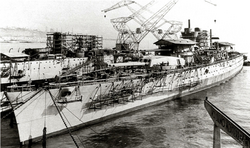
Between 1939 and 1943, the regime spent considerable resources on the modernisation of its navy, air force and army. The re-armament was assisted markedly by the successful renegotiation of the Treaty of Keisi with Xiaodong, which saw Etruria’s owed reparations made in a considerable lump sum of €3,990,100,000 (estimated to be €10,499,059 as of 2019) in 1939. A vast portion of this sizeable sum went directly into the mechanisation of the Army and the refitting of Etruria’s six battleships. The Etrurian Republican Army was increased from 550,000 soldiers as of 1936 to 1,400,000 by 1941, the number of tanks rose from 1,200 in 1936 to 2,500 in 1941, and the number of aircraft under the Etrurian Republican Air Force (ERAF) increased from 985 to 2,204 by 1942. This re-armament however, came at a cost for the Etrurian population, who saw healthcare, education and living standards fall, even as industrial capacity grew on average by 8%. Etruria's military build-up was noted by other Euclean powers, yet little action was taken to confront the growing militarisation of Etruria or its rapidly expanding capabilities. In late 1939, a tentative effort by Estmere to confront Etruria's naval build-up was met with assertions from Etruria that the naval build up was to confront the "rising Marolevic threat."
Noted historian, Leonardo Craxi wrote in 1996, “even as the Etrurian Republican Armed Forces were rebuilt and even improved from their peak in the Great War, the Etrurian citizen made it happen by making some stark economic sacrifices. Living standards and the very quality of living decreased, wages shrank even as the Florin got you more than before. Healthcare spending was slashed, unemployment benefit was slashed, children’s education was obliterated to just a regurgitation of regime propaganda." Leading military historian, Richard Harris also described the Etrurian military buildup as "astounding", he cited the rapid expansion of armoured vehicles and mechanisation, as well as the mass production of modern fighters as evidence of the regime's success at "economically, socially and politically mobilising Etrurian society for renewed war."
Throughout the military build-up, the regime developed its ideology, as well as its worldview. The new regime sought to transform Etrurian society, emulating the Solarian Republic in structure, propaganda and government system. It further sought to transform Etruria it a "legionary nation", who's military might and geographical expanse would secure the country as the "natural and truest successor to our dear Solaria of old" and as Euclea's dominating power. To achieve this, the country would need to secure Vera Etruria or (True Etruria), through war and military expansion, which they saw the greatest "transformational tool of humankind."
Pre-war events
Ajadahya Expeditions
Operation Lexicon
Operation Terracotta
Piraean clashes
Annexation of the Amathian Occupation Zone
War
Invasion of Piraea and expansion (1943-1944)
- Etruria invades and military defeats Piraea - July to November 1943
- Lack of CN condemnation
- Etruria invades western Amathia Dec 1943
- Etruria invades Tsabaran Mandate - Feb to Mar 1944
- Etruria invades Montecara - Mar 1944
- Etrurianisation of Piraea begins in Apr 1944.
- CN approves small intervention in Tsabara - Jun 1944
- CN force defeated and CN opts for full-scale intervention in Sep 1944
Invasions of Coius (1943-1944)
- In response to CN intervention, Etruria beefs up its colonial forces, including a mass conscription of Satrians to the Corpo di Soldati Ausiliario Satriani and Badawiyans to the Sicarii.
- Etruria invades Estmerish concession ports in Zorasan - December 1943 to January 1944.
- Etruria and the CSAS invade Estmerish colonies in Satria - January to March 1944
- Etruria invades the Irvadi Mandate from Bahia Etruriana - January to February 1944.
- Fighting continues in Tsabara - January - October 1944.
- First clashes between Etruria and the Pardarian Revolutionary Resistance Command in southern Pardaran.
- Xiaodongese steps up support for PRRC and Kumuso in resisting Etrurian colonial rule.
CN Intervention and rebellion (1944-1945)
- CN forces began to amass in northern Euclea, plans are drawn up to break Etrurian defences around the Aurean Straits.
- First CN forces arrive in northern Tsabara to support Estmerish and local forces.
- Big naval battle between Etruria and Estmere, halts CN approach to Montecara.
- Etrurian Occupation of Piraea begins to see the first full-scale massacres and Etrurianisation of Piraea - November 1944 to December 1945
- Etrurianisation of Amathia begins - November 1944 to April 1945
- CN intervention in Paretia (War in Paretia) - February 1944 - December 1945
- Satrian Rebellion
- Etruria-PRRC conflict
- Colonial uprisings throw Etruria into chaos in Satria and Zorasan, alleviating pressure on CN in Tsabara
War in Satria (1944-1946)
- Details about Etrurian invasions of Estmerish colonies.
- Satrian Rebellion
- Heavy fighting
- Stiff resistance by Etruria and its colonial loyalists.
- Atrocities
- CN reinforcements
- Collapse of Etrurian positions
War in Badawiyan and Zorasan (1944-1946)
- Details on war in Tsabara
- PRRC-Etrurian conflict
- Quasi Zorasani civil war due to relative support of the puppet Shahdom.
- Etrurian positions steadily collapse and forces withdrawn to Euclea to face off the CN
- Race for Zahedan between de-facto independent Shahdom and the PRRC
- Etrurians pushed back in Tsabara
Tide turns (1945-46)
- Complete withdrawal of Etruria from Tsabara and Zorasan by early 1946.
- Etrurian collapse in Satria, near total loss of all Satrian Army Groups.
- Gaullica enters the war, opening up northern front and reinforcing CN in Paretia
- Naro and allies breakthrough in Amathia, endangering Carinthia
- Piraean partisans inflicting heavy losses on Etruria - Etrurianisation turns into genocide.
Etrurian collapse
- CN advances into Carinthia and eastern Vespasia from Amathia and Paretia respectively.
- Etrurian navy defeated at the Battle of Emessa
- Emessa liberated by CN
- Liberation of Montecara – 8–10 February 1946
- CN stages naval landings in southern Etruria, threating to split the country off from Solaria.
- War is beyond saving, regime begins to collapse.
- Co-Leader Tassinari commits suicide.
- Co-Leader Caviglia flees Solaria for Tarantine Mountains but is lynched by his own people.
- Interim emergency govt declares unconditional surrender.


